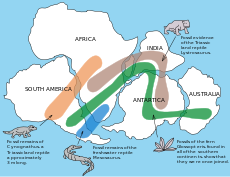- Cynognathus
-
Cynognathus
Temporal range: Early - Middle Triassic, 247–237 MaFossil skull of Cynognathus crateronotus Scientific classification Kingdom: Animalia Phylum: Chordata Class: Synapsida Order: Therapsida Suborder: Cynodontia Family: Cynognathidae Genus: Cynognathus Binomial name Cynognathus crateronotus
Seeley, 1895Cynognathus crateronotus was a meter-long predator of the Early to Middle Triassic. It was among the more mammal-like of the Synapsids, a member of a grouping called Eucynodontia. The genus Cynognathus had an almost worldwide distribution. Fossils have so far been recovered from South Africa, South America, China and Antarctica.
Contents
Names
The genus Cynognathus (from Greek κυνόγναθος, meaning "dog jaw") has been given several different names over the years. It has also been known as Cistecynodon, Cynidiognathus, Cynogomphius, Karoomys, Lycaenognathus, Lycochampsa, Lycognathus, and Nythosaurus. In addition, according to the records of the Peabody Museum of Natural History at Yale, Richard Owen used the name Nythosaurus for this animal in 1876. This usage seems to be unconnected with Cynognathus. Cynognathus is presently the only recognized member of family Cynognathidae. Opinions vary as to whether all remains belong to the same species.
The species Cynognathus crateronotus is also known as Cistecynodon parvus, Cynidiognathus broomi, Cynidiognathus longiceps, Cynidiognathus merenskyi, Cynognathus beeryi, Cynognathus minor, Cynognathus platyceps, Cynogomphius berryi, Karoomys browni, Lycaenognathus platyceps, Lycochampsa ferox, Lycognathus ferox, Nythosaurus browni. Fifteen different names for one Mesozoic creature might be regarded as excessive, but it's by no means a record. The dinosaur Plateosaurus engelhardti, has been named well over 20 times.
The genera Karoomys, Cistecynodon and Nythosaurus are known only from tiny juveniles, while Lycognathus cucullatus seems to be a misidentified snake from the Balearic Islands, although confirmation is elusive.
Fossil locations
Fossils have been found in Karoo; the Puesto Viejo Formation; Fremouw Formation, in South Africa/Lesotho; Argentina; Antarctica; and China
Age
Cynognathus lived between the Spathian (Lower Triassic) and the Anisian (Middle Triassic).
Description
Cynognathus was a heavily built animal, and measured around 1 metre (3.3 ft) in body length. It had a particularly large head, 30 centimetres (1.0 ft) in length, with wide jaws and sharp teeth. Its hind limbs were placed directly beneath the body, as in mammals, but the fore-limbs sprawled outwards in a reptilian fashion.[1]
The dentary was equipped with differentiated teeth that show this animal could effectively process its food before swallowing. The presence of a secondary palate in the mouth indicates that Cynognathus would have been able to breathe and swallow simultaneously.
The lack of ribs in the stomach region suggests the presence of an efficient diaphragm: an important muscle for mammalian breathing. Pits and canals on the bone of the snout indicate concentrations of nerves and blood vessels. In mammals, such structures allow hairs (whiskers) to be used as sensory organs.
See also
- Thrinaxodon
- Tritylodontids
- Cynognathia
- Evolution of mammals
- Paleoworld- Featured in the episode "Tail Of A Sail".
Reference
- Seeley (1895), "Researches on the structure, organization, and classification of the fossil Reptilia. Part IX., Section 5. On the skeleton in new Cynodontia from the Karroo rocks". Phil. Transactions of the Roy. Soc. of London, series B 186, p. 59–148.
Kingdom: Animalia · Phylum: Chordata · Class: Synapsida · Order: Therapsida · (unranked): Neotherapsida · (unranked): Theriodontia · (unranked): EutheriodontiaMajor clades Early cynodonts Basal cynodontsOther generaEpicynodontiaThrinaxodontidaeOther basal
epicynodontsBoloridon · PlatycraniellusCynognathia CynognathidaeCynognathusGomphodontia /
TritylodontoideaDiademodontidaeTrirachodontidaeTrirachodontinaeCricodon · Langbergia · TrirachodonSinognathinaeBeishanodon · SinognathusAndescynodon · Arctotraversodon · Boreogomphodon · Colbertosaurus · Dadadon · ?Gornogomphodon · Habayia · Luangwa · Massetognathus · Maubeugia · Microscalenodon · Nanogomphodon · Pascualgnathus · Plinthogomphodon · Protuberum · Rosieria · Santacruzodon · Scalenodon · Theropsodon · TraversodonGomphodontosuchinaeBienotherium · Bienotheroides · Bocatherium · Dianzhongia · Dinnebitodon · Kayentatherium · Lufengia · Nearctylodon · Oligokyphus · Polistodon · Stereognathus · Tritylodon · Xenocretosuchus · Yunnanodon · YuanotheriumProbainognathia LumkuiidaeLumkuiaMammaliaDromatheriidaeTritheledontaBrasilodontidaeTherioherpetidaeTritheledontidaeChaliminia · Diarthrognathus · Elliotherium · ?Eoraetia · Irajatherium · Mitredon · Pachygenelus · PattsiaRelated categories CynodontsCategories:- Cynodonts
- Triassic synapsids
- Triassic extinctions
- Prehistoric synapsids of South America
- Prehistoric synapsids of Africa
- Prehistoric synapsids of Asia
- Extinct animals of Antarctica
Wikimedia Foundation. 2010.




